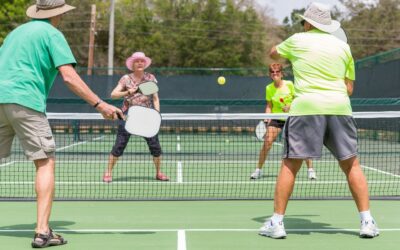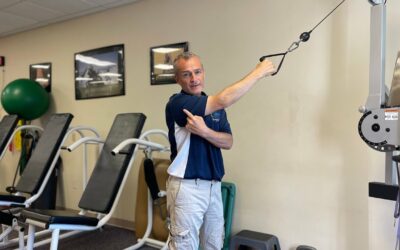Pickleball Safety for Seniors
Whether you are in your 40’s, 60’s, or 80+, pickleball safety is a top priority when you are a recreational pickleball player.
I am 47 years old and the last thing I need is to get hurt while playing pickleball. Silly injuries not only take me out of the game, but they also make the rest of my life more challenging.
As a physical therapist, I see pickleball injuries in my clinic all the time. Here is a list of my top 10 tips for staying safe while playing pickleball as an adult in 2022.
1. Stay Hydrated
Pickleball is often played outdoors and in many warm climates staying properly hydrated can be a real challenge. I recently published an article about getting muscle cramps in pickleball and a big part of that article discussed hydration.
The best clinical guidelines on staying hydrated while playing any recreational activity in warm weather suggest monitoring body weight and drinking enough fluids to maintain body weight.
For example, a 150-lbs adult might lose 2 lbs of body weight playing a competitive pickleball game in 87-degree weather. This person should consume approximately 24 ounces of fluids during the match or shortly after.
2. Proper Warmup
A proper warmup does not always mean stretching. Warming up your body for peak physical performance includes increasing the actual temperature of your body, increasing the neurological activity within your nervous system, and making sure all of your body’s muscles and joints are able to move through a full range of motion.
Body Temperature
Just as warming up your car on a cold winter morning, warming up the body with light cardiovascular activity can help improve synovial fluid viscosity and joint lubrication.
Gentle jogging, jumping jacks, or other low-impact and low-intensity exercise for 2 to 5 minutes will elevate the temperature of your joints and muscles while priming your body for movement.
Nervous System
Muscle performance, balance, and coordination are controlled largely by the body’s central nervous system. Intentional movements and reflexive reactions may benefit from “waking up” the body’s nervous system.
After increasing your body’s temperature and heart rate, some plyometric jumps or sprints might be a great way to excite the nervous system and get it ready for action.
Range of Motion
Finally, the last part of any comprehensive warmup includes a range of motion exercises. This is slightly different from static stretching.
Range of motion exercises for pickleball includes moving all the major joints of the body through a complete range of motion.
Trunk twists, shoulder swings, and hip circles are a couple of the most common range of motion warmup activities.
3. Check the Environment
A clean and well-lighted court is important. I have seen players playing on courts with leaves or other debris. Be sure your pickleball court’s playing surface is clean, dry, and well-lighted.
Look for cracks, sand, or gravel that might cause you to slide or trip.
If you will be playing later in the evening be sure to prepare for sunset and dim lighting.
4. Well Matched Opponents
Everyone loves a challenge, but be sure you aren’t playing too far above or below your ability level.
I often see players hoping to improve their game playing far better opponents. It can be great to play up, but keep in mind that you will improve your skills and ability in training and during practice, not in a competitive match.
Use competitive gameplay to assess your progress, but choose a competition level that is well matched to your current abilities.
5. Cool Down
Just as a proper warmup is a major part of pickleball safety, a proper cool-down is just as important.
I like to teach my pickleball athletes to use the time after a match to perform the static stretches not done during the warmup.
Using tools like a foam roll or massage gun is also a great option to incorporate during your cool down.
If the match was really intense, I often recommend a light-intensity jog or pedaling a stationary bike for 5 to 10 minutes as a way to pump blood back out of the legs and into the system.
6. Strength Training
No pickleball safety program should omit a comprehensive strength training program. While the sport of pickleball requires quickness, agility, timing, and coordination, it also requires strength.
Having adequate strength to move your body through space and control the rapid acceleration/deceleration of your arms and legs are required to reduce your chances of injury.
A whole-body strengthening program may be performed with simple bodyweight exercises or resistance training. Many pickleball players will carry elastic bands in their equipment bag, but making time for a structured resistance program could reduce pickleball safety as well as improve pickleball performance.
7. Power Training
Strength and power are not the same things.
Strength is the body’s ability to generate force.
Power is the body’s ability to generate force quickly.
A pickleball and pickleball paddle is light and requires more power than strength. Some examples of power exercises might include swinging a lightweight large face paddle against wind resistance. Other power exercises include plyometric training.
Bonus Tip
Pickleball safety should also include a physical therapy evaluation.
Of course, I am biased toward finding and working with a great physical therapist, but I believe the best way to stay safe playing pickleball is to connect with a physical therapist who understands the game of pickleball and who can perform a comprehensive orthopedic examination on you.
This examination and evaluation will help you identify potential weaknesses and possible injury risks. Your physical therapist will also help create a treatment plan to minimize injury risk while optimizing for performance.
For more safety tips watch Coach Simone’s video Safety for Beginners

Anthony Maritato, PT
Physical Therapist / Author
Hi! My name is Anthony Maritato, PT but please call me Tony. I have been a licensed physical therapist since 2006 and a strength and conditioning coach since 2000.
I am new to the sport of pickleball, but I have been working with pickleball athletes for most of my physical therapy career. To learn more about my physical therapy clinic visit Total Therapy Solutions.
More Related Articles
Pickleball In The News
Originally Published on March 11, 2021 by Staff 1. Pickleball- the Fastest Growing Sport in the USA Though originated in 1965, the game of pickleball did not get much popularity until the recent years. It is one of the fastest growing sports in the country as people...
Pickleball Strength Training Gym Program
This pickleball strength training gym program is a general program designed for recreational players who want to reduce injury risk and improve performance. Pickleball strength training [Video] Watch this video to learn my 5+ favorite pickleball strength training...
Best Pickleball Lessons Online
It should be no surprise that everything is moving online, and finding pickleball lessons online are not unique. In fact they are gaining popularity. What I love about receiving pickleball lessons online is that I can access LIVE coaching, video analysis, email and...
Pickleball for Parkinsons Disease
In my physical therapy clinic I use pickleball drills and training to help patients with Parkinson's disease all the time. Parkinson's disease is a progressive, neurodegenerative disease that affets movement. Patients will present with different symptoms from rigidity...
Best Pickleball Training Machines for 2022
I have been looking for pickleball training machines that allow me to practice without a partner. Below is a list of some of the best pickleball training machines I have found in 2022 and what I like / dislike about each one. 1.) Slam Master While the idea behind...
How to Avoid Falling in Pickleball
The reality is, that people will fall. Fall prevention is kind of a silly concept to me. I try to focus more on being able to fall without getting hurt. Yes, we want pickleball players to improve their balance and coordination, but falls will happen and the goal of...


